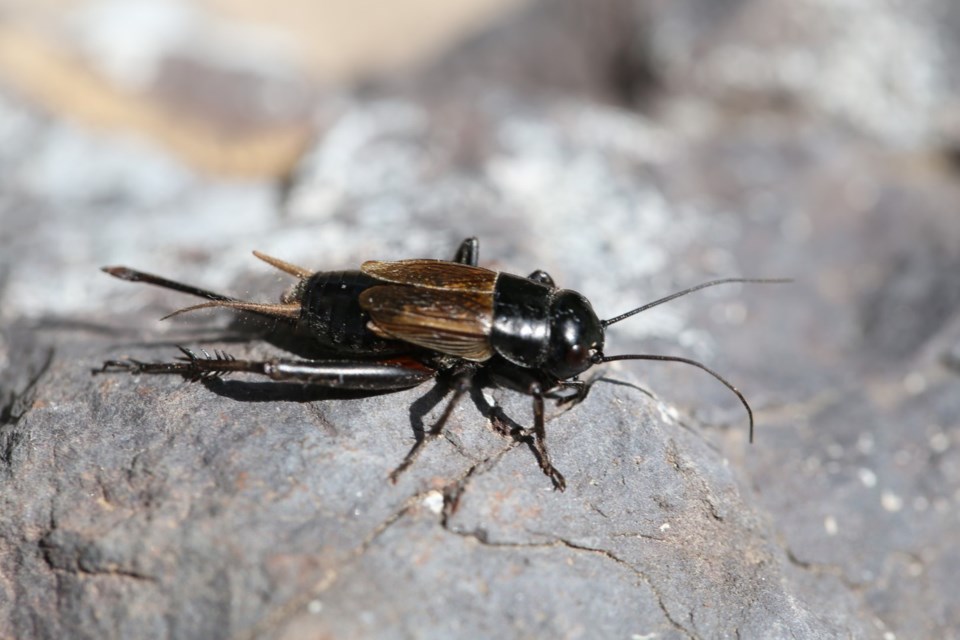Many readers will be familiar with rather persistent ‘buzzing’ noises, rapidly repeated, either in the garden during late summer evenings or in homes in late fall, usually emanating from under the fridge, freezer, stove, etc., indeed anywhere that is dark and warm. The source of these chirpings is probably a male cricket: In the Prairie Provinces, the culprit is most likely the fall field cricket (Gryllus pennsylvanicus), while in Britain it would be the house cricket (Acheta domesticus) which achieved fame in one of Charles Dickens’s Christmas Stories ‘The Cricket on the Hearth’.
These species are but two examples of a large group of insects (perhaps 10,000 species worldwide, though fewer than 30 occur in Saskatchewan) whose males can ‘sing’ (I use the term loosely!). Others include camel crickets, bush crickets, tree crickets, mole crickets, and Mormon crickets. The term ‘cricket’ is derived from ‘criquer’, old French for to creak, rattle or crackle, about the noise made by courting males.
Crickets share several features with their close relatives, grasshoppers: These include hind legs elongated for jumping and, in females, an ovipositor at the rear end used to deposit eggs in soil or plant stems. Unlike grasshoppers, however, they have antennae that are as long as their body, are generally nocturnal and seldom fly.
As I write this article (early July), there are plenty of black fall field crickets in my acreage garden. Some are already about half-grown (12.5 mm [one-half inch) long, but most are smaller, around 6 or 7 mm [one-quarter inch]. With the hot dry spring we experienced this year, the overwintered eggs began hatching about two weeks earlier than usual, in the first half of June. The young crickets will pass through between seven and nine moults before becoming adults. Thank goodness that most will succumb to predators, parasites or disease before reaching adulthood.
We can expect to see (hear?) adults by early August. They are typically black, about 25 mm (1”) long, and have antennae as long as the body and a pair of long sensory structures (cerci) at their hind end. Adult males and females are easily distinguished, as females have a long, needle-like ovipositor, while males have adaptations on their forewings which when rubbed together produce a species-specific song. Its purpose is to attract females for mating. Studies have shown that females select their partner with great care; for example, they can distinguish between the songs of males based on age, preferring to mate with older individuals. Mating and egg-laying take place at night from late August onward till low temperatures prevail and the adults die. Over their lifetime, individual females may lay several hundred eggs, in batches of up to 40, in loose soil. The eggs are in the overwintering stage, able to withstand the severe freezing temperatures of a prairie winter. Crickets prefer habitats where the soil is lumpy and cracked where they can spend the day hidden from predators and deposit their eggs.
Unlike grasshoppers which are herbivorous and whose food preferences can be quite specific, crickets are generally omnivorous, eating plant and animal material, fresh or decaying, with equal enjoyment. It may be because of the field crickets’ varied diet that they are seldom a pest in gardens or an agricultural setting. Equally, they are unlikely to find use as predators against pests, as shown by a study carried out by local scientists around the time that crucifer flea beetle populations were rising as increasing acres of cropland were being seeded to canola. In laboratory tests, field crickets readily ate the flea beetles (the only source of food) when restricted to small plastic containers; however, in field trials, no significant effect on the beetle population was noted, presumably due to the variety of food available to the crickets in the field cages. That said, there is evidence that crickets accumulate near grasshopper egg-laying areas and actively search for and dig to locate their eggs which they eat eagerly. Thus, they may exert a measure of control over these major pests.
Like grasshoppers, crickets are highly nutritious and eaten by humans and many other animals in many parts of the world including Asia, Europe and North America. For humans, they are typically served dry-roasted, deep- fried or chocolate-coated or are ground into a form of flour. Like grasshoppers, they are a major food source for songbirds and other small vertebrates during the breeding season and before migration or hibernation. In Europe and North America, house crickets are a major item in the diet of many exotic pets, notably reptiles and amphibians. Until recently, the species used was A. domesticus. However, in 2002 (Europe) and 2010 (North America) the cricket paralysis virus decimated mass-cultured populations of A. domesticus, leaving the pet trade momentarily in disarray. Fortunately, a suitable substitute, the Jamaican house cricket (A. assimilis) was quickly found, and this is now the go-to food of choice sold in pet stores.
Finally, a few words of caution: Before pulling out the spray can of insecticide to exterminate the intruder under your fridge, be aware that the presence of a cricket in the house has long been thought to bring good fortune. As Mrs Peerybingle said to her husband in Dickens’ novel “To have a Cricket on the Hearth is the luckiest thing in all the world!”
Cedric Gillott is a retired entomologist and professor emeritus in the Department of Biology at the University of Saskatchewan.
This column is provided courtesy of the Saskatchewan Perennial Society (SPS; [email protected]). Check our website (www.saskperennial.ca) or Facebook page (www.facebook.com/saskperennial) for a list of upcoming gardening events.




